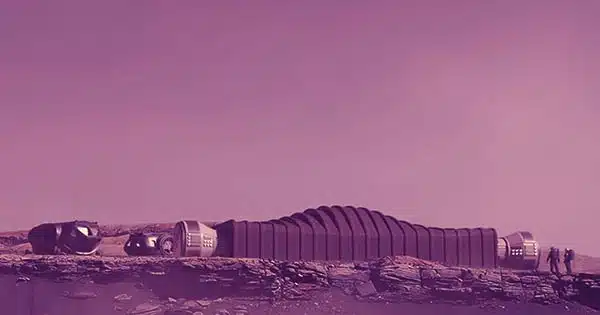Under the team members’ boots, red sand sways. A stony mountain range appears to be emerging from the Martian horizon in the distance. The gear required for the 12-month expedition, including solar panels, is covered in a thin coating of red dust.
In reality, this scenery is not 145 kilometers distant. We are in a huge white warehouse in a corner of the Houston NASA Johnson Space Center, near the disc golf field and directly on the tram route for visitors and school groups.
However, starting in June, four willing test volunteers will spend a year confined while acting as though they were living on Mars.
Nasa researchers said they’re doing everything they can to make the experiment as realistic as possible so they can learn about the impact of a year in isolation with limited resources on human health.
“As we move from low Earth orbit to Mars, we’ll have a lot more resource constraints than we have on the International Space Station, and we’ll be a lot further away from Earth or any help from Earth,” said Dr Grace Douglas, principal investigator for the Crew Health Performance Exploration Analog, or Chapea for short.

The four crew members will reside in a modest dwelling unit that was built with the aid of a massive 3D printer to mimic how NASA may build houses using Martian soil on the planet’s surface. They will carry out research, cultivate food, exercise, and undergo frequent testing so that scientists can understand what a year on Mars may do to the body and mind.
Dr. Suzanne Bell, director of the Behavioral Health and Performance Laboratory at the NASA Johnson Space Center, remarked, “This is truly an extreme situation. “You’re asking people to live and work together for more than a year. They will need to work well together in order to do well, in addition to getting along well.
The next modest step NASA will take to put people on the surface of Mars is to watch four individuals spend a year in a 3D-printed box. As early as the 2030s, according to Nasa, people might be sent to the red planet. The initial flight may take nine months one way, leaving the astronauts on Earth for 2.5 years before beginning the protracted journey back to Earth.
The agency’s Artemis program is already hard at work planning for such a journey. For the first time since 1972, Artemis is sending astronauts back to the Moon, including the first person of color and woman to walk on another celestial body. Nasa is also launching Gateway, a space station that will circle the Moon and act as a stopover for Mars-bound missions, as part of the Artemis missions.
Getting to the Moon implies going to Mars, and going to Mars means putting a crew’s physical and behavioral health to the test. This is when Chapea enters the picture.
The mission is hardly the first long-term test NASA has conducted before sending people farther into space. Scott Kelly and Mikhail Kornienko, two astronauts, stayed aboard the International Space Station for a full year in 2015. In order to understand the impacts of prolonged spaceflight, scientists compared Senator Mark Kelly, Kelly’s identical twin who lives on Earth, with his biometrics. Additionally, a number of “analog missions” are being carried out by NASA scientists to recreate various aspects of space travel on Earth.
“No matter how difficult, large, or expensive something like this is, it’s easier than doing it in space,” said Scott Smith, director of NASA’s Johnson Space Center’s Nutritional Biochemistry Laboratory. “So we put people to sleep when we want to look at bone loss and muscle loss.” We went to Antarctica to study vitamin D and folks who do not get enough sunlight. When we consider oxidative stress, we descend to the depths of the ocean. And we develop rooms like this when we want to study confined situations and stress.”
The four crew members who will enter the habitat in June haven’t been given a name by Nasa, but the agency did say that they were chosen based on standards comparable to those used for the astronaut corps. They are professionals with advanced degrees in STEM (Science, Technology, Engineering, and Math) who also meet the necessary physical and psychological requirements for the experiment.
For the next year, the 1,700-square-foot house has four individual quarters and a communal bathroom with a shower and toilet. There are specialized workstations, a medical station, and a lounge area, which includes board games such as Settlers of Catan: Starfarers Edition and Monopoly, as well as a Play Station 3 and Super Nintendo console. The crew members will cultivate ready-to-eat food like tomatoes and leafy greens in inside greenhouses, allowing Nasa to assess the quality and efficacy of its plan to grow crops on Mars.
Nasa scientists working on designing things that may be reused in orbit will study their garbage. There will also be a 22-minute communication lag between the Chapea residents and the outside world, similar to what astronauts experience while talking with Earth.
“The whole experience is impacting the human, and what we’re looking at is the response to the human,” Smith explained. “All of that will most likely show up in the data we’re collecting.”
The 1,200-square-foot sandbox outside is the most eye-catching aspect of the Chapea habitat. The team will wear false space suits and enter the “outdoor” half of the habitat – an inflated bubble filled with sand and a simulated Martian landscape – through a fake airlock.
Here, participants will execute virtual reality-enhanced missions (Nasa refers to them as “Mars walks”) in pairs that will give the impression that they are actually walking over the surface of the red planet.
As our footprint on Mars grows, some of those treks will require the application of fundamental geology skills, such as the ability to spot interesting rocks, photograph them, and bring a sample inside for examination. They may also require the use of site appraisal abilities. Other missions will entail cleaning sand off of the habitat’s exterior solar panels or doing maintenance on the Chapea building. They could hike for hours using treadmills and VR simulators, much like actual astronauts may have to do research and harvest materials on Mars.
However, in addition to gathering data from the tests carried out by the Chapea volunteers, Nasa will also constantly watch them for symptoms of physical and emotional stress.
Nasa says it wants to make the experiment as Mars-like as possible, which means not just isolation, but extra manufactured stressors like resource limitation, equipment failure, and heavy workloads.
For instance, the crew members will need to properly distribute their limited food supplies. Regular blood samples and psychiatric tests will be required of them.
In particular, Bell added, “We are very interested in the stress response to that prolonged isolation and confinement.” “We don’t have a lot of information on what occurs to someone who is isolated for a year.”
According to Douglas, participants are free to quit the habitat and the experiment at any time, and two backup people have also been chosen in case things go wrong. Bell remarked, “We’ve set the team up for success, but before we actually send people to Mars, we still need that data.”















